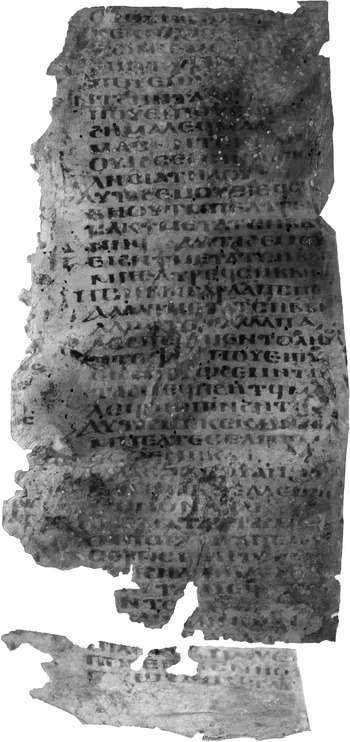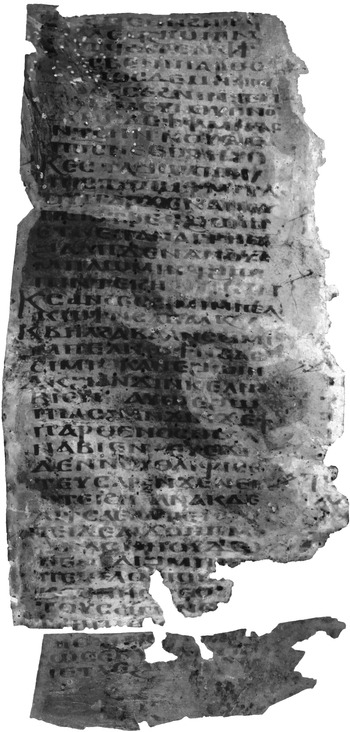Having discussed various features of P.MorganLib. 265 as a manuscript, I am now going to discuss the Fayyūmic text of First Corinthians, of which this manuscript is a witness. I will first survey the other Fayyūmic manuscripts of First Corinthians and suggest that they all bear witness to the same version (fa), then analyse the relationship between fa, the medieval Bohairic version (bo) and the text of codex C, and finally discuss the value of the newly published witness to fa for the history of the Greek text of First Corinthians.
6. Version
To the best of my knowledge, in addition to P.MorganLib. 265, there are five other witnesses to First Corinthians in Fayyūmic; four of them are written in dialect F5, one in dialect F4. Of these five manuscripts, two have parallel text with P.MorganLib. 265:
– P.MorganLib. 268. A fragmentary leaf from a codex, comprising 1 Cor 14.25–7, 32–5; 15.1–4, 9–12. Despite the fact that this is the only witness to the Fayyūmic First Corinthians on papyrus, its palaeography (the manuscript is written in bimodular uncial, the letters ϣ and ϭ with their ‘Southern’ shapes) and non-standard orthographyFootnote 1 point to a rather late (eighth- or even ninth-century?) date. Leo Depuydt's transcription of the fragment is often unreliable.Footnote 2 A comparison of verses 1 Cor 15.3–4, 9–12 in P.MorganLib. 265 and 268 reveals that the two manuscripts bear witnesses to the same version; the differences are few and rather minor – viz. ⲉϫⲉⲛ- vs ϩⲁ- (1 Cor 15.3), ϩⲛ- vs ⲛ- (1 Cor 15.10), ⲇⲉ vs ϭⲏ and ⲧⲱⲛϥ vs ⲧⲱⲟ̣ⲩ̣ⲛ (1 Cor 15.12).Footnote 3
– P.Vindob. K 3280 + K 3921 + K 9311. Three fragmentary parchment leaves from a palimpsest, whose scriptio superior comprises 1 Cor 15.29, 32, 43–4, 45–7, 57–8; 16.1–2. According to Paul E. Kahle, the manuscript was copied in the seventh century or earlier.Footnote 4 The fragments were edited by Walter C. Till,Footnote 5 who could not identify the contents of the smallest of the three fragments – viz. P.Vindob. K 3280. Later, Kahle observed that the flesh side of the fragment contains 1 Cor 15.29, and the hair side 1 Cor 15.32.Footnote 6 That this manuscript and P.MorganLib. 265 bear witness to the same version is clear from the fact that the poorly preserved text of 1 Cor 15.29 in P.Vindob. K 3280 can be easily restored with the help of P.MorganLib. 265. Unfortunately, since the fragment has been missing since 1971,Footnote 7 the following reconstruction is based solely on Till's transcription and needs to be revisited, should the fragment ever be rediscovered: [ⲛⲏ ⲉⲧϫⲱ|ⲕ]ⲉ̣ⲙ ⲙ̣[ⲙⲁⲩ ⲉϫⲉⲛ ⲛⲓ]|ⲗⲉϥⲙⲁⲟⲩ[ⲧ ⲉϣϫⲉ ⲇⲉ] | ⲛⲛ̣ⲓⲗⲉϥ̣[ⲙⲁⲟⲩⲧ ⲗⲱ | ⲛⲉ]ⲧ̣ⲱ̣[ⲛⲟⲩ ⲉⲛ].
The only extant fragment in dialect F4 has parallel text with P.MorganLib. 268:
– Oxford, Bodleian Library, Ms.Copt.g.97(P). A fragment from a parchment codex whose text was arranged into two columns. It is paginated [ⲣ]ⲛⲇ–ⲣⲛ̣[ⲉ] (‘154–5’) and preserves the top six lines on the right column of the recto and the left column of the verso. The existence of this fragment was signalled by Anne Boud'hors and Chièmi Nakano in 2005.Footnote 8 The recto, preserving 1 Cor 14.31, reads: [ⲅⲁⲣ] ⲙⲙⲁⲧⲉⲛ | [ⲧ]ⲏⲗⲧⲉⲛ ⲕⲁⲧⲁ | [ⲟ]ⲩⲉⲓ̇ ⲟⲩⲉⲓ̇ ⲉⲉⲗ|ⲡⲣⲟⲫⲏⲧⲉⲩⲓⲛ: |5 ϩⲓⲛⲁ ⲛⲥⲉϫⲓ̣ ⲥ̣ⲃ̣ⲱ̣ | ⲧⲏⲗⲟⲩ vac ⲁ̣[ⲩⲱ]. The verso, preserving 1 Cor 14.34, reads: ϩⲛ ⲛⲓⲉⲕⲕⲗ[ⲏⲥⲓⲁ] | ⲛ̇ⲥⲉⲟⲩⲁϩ ⲥⲉ[ϩⲛⲓ] | ⲅⲁⲣ ⲛⲉⲩ ⲉⲛ ⲉ|ϣⲉ̣ϫ̣ⲓ̣ vac ⲁⲗⲗⲁ ⲙ[ⲁ]|5ⲗ̣ⲟ̣ⲩ̣ⲉ̣ⲗϩⲩⲡⲟ|[ⲧⲁⲥ]ⲥ̣ⲉⲥⲑⲉ ⲕⲁ|[ⲧⲁ]. Since the extant text of 1 Cor 14.34 agrees verbatim with that in P.MorganLib. 268,Footnote 9 we can be certain that Ms.Copt.g.97(P) bears witness to the same version as P.MorganLib. 265, 268 and P.Vindob. K 3280 + K 3921 + K 9311. To judge from the parallel text of bo and P.MorganLib. 268, Ms.Copt.g.97(P) must have had ca 22 lines per column. When it was complete, the leaf measured ca 155 × 135 mm (height × width). Although we should certainly be cautious when assigning dialects to small fragments such as this one, everything in Ms.Copt.g.97(P) – and especially the form ⲛⲉ⸗ (‘to, for’; F5 ⲛⲏ⸗) – indicates that it belongs to the F4 corpus, which means that Ms.Copt.g.97(P) must have been produced sometime between the fourth and the sixth centuries ce.
There are also two manuscripts that do not preserve any text parallel with the other Fayyūmic witnesses to First Corinthians:
– P.Mich.inv. 158 (9) + P.MorganLib. 264. A fragmentary codex comprising the Pauline epistles, whose extant leaves are divided between the University of Michigan Library and the Morgan Library & Museum. The Morgan fragments remain unpublished, while most of the Michigan fragments were edited by W. H. Worrell,Footnote 10 who dated the manuscript to ca 600 ce; Kahle suggested a similar date.Footnote 11 The codex may have belonged to the library of the White Monastery.Footnote 12 Although this manuscript is by far our most important witness to the Pauline corpus in Fayyūmic, only one leaf (P.MorganLib. 264, fol. 14) of First Corinthians survives, preserving most of its first chapter (1 Cor 1.1–7, 9–14, 16–24).
– P.Lond.Copt. 1.507. A strip of parchment, which once was part of a codex leaf, comprising 1 Cor 8.7, 12–13; 9.6–7, 12. After the strip was cut off, a liturgical aide-mémoire in Sahidic (P.Lond.Copt. 1.512) was inscribed above the older text.Footnote 13 P.Lond.Copt. 1.507 was edited by W. E. Crum.Footnote 14 Kahle dated it to the seventh century or earlier.Footnote 15
Since no text has survived which would parallel that of these two manuscripts and the other four (i.e. P.MorganLib. 265, 268, Oxford, Ms.Copt.g.97(P) and P.Vindob. K 3280 + K 3921 + K 9311), we cannot ascertain whether they bear witness to the same version of First Corinthians. However, although it is not impossible that the five extant Fayyūmic manuscripts bear witness to two (or even three) different versions of First Corinthians, it seems reasonable to surmise that they all in fact represent one single version (fa) – not only on the principle of lex parsimoniae, but also because, in all five, the text is strikingly similar to that of bo.
Indeed, a synoptic comparison of the vestiges of First Corinthians in Fayyūmic with the Bohairic text immediately reveals that, if we disregard the dialectal differences, the two versions are next to identical. This similarity between fa and bo is remarkable and requires explanation. In the history of scholarship, two major Coptologists have expressed directly opposing views on the matter. According to Kahle, bo and fa are similar in several New Testament books, because, in these instances, fa ‘was taken over’ from and ‘preserves almost literally the text of’ bo. In order to support his claim that fa is dependent on bo, Kahle refers to the fact that the standard Fayyūmic nomina sacra ⲫ︦ϯ︦ and ⲡϭ︦ⲥ︦ derive from Bohairic.Footnote 16 This argument was refuted by H. J. Polotsky, who noted that the borrowing of nomina sacra from a neighbouring dialect does not provide sufficient grounds to posit literary dependence.Footnote 17 The question about the relationship between fa and bo thus remains open, though Polotsky himself felt that ‘it is not only possible, but plausible’ that the former has priority over the latter.Footnote 18
With respect to First Corinthians, a comparison of fa and bo makes either of these two simple solutions (fa → bo vs bo → fa) rather unlikely. That neither of them can be a daughter version of the other is best evidenced by those instances where bo and fa support different variant readings of the Greek tradition. For instance, at 1 Cor 3.5, bo reads ⲟⲩ ⲟⲩⲛ ⲡⲉ ⲁⲡⲟⲗⲗⲱ ⲟⲩ ⲇⲉ (±ⲡⲉ) ⲡⲁⲩⲗⲟⲥ, thus supporting the variant which the critical editions of the Greek text consider to be original (τί οὖν ἐστιν Ἀπολλῶς; τί δέ ἐστιν Παῦλος; ‘What, then, is Apollos, and what is Paul?’). Fa, on the other hand, reverses the order of Paul and Apollos and changes ‘what’ to ‘who’, reading ⲛⲓⲙ ⲟⲩⲛ ⲡⲉ ⲡⲁⲩⲗⲟⲥ̣ ⲛⲓⲙ ⲇⲉ ⲡⲉ ⲁⲡⲟⲗⲗⲱ̣, which corresponds to τίς οὖν ἐστιν Παῦλος, τίς δὲ Ἀπολλῶς; (‘Who, then, is Paul, and who is Apollos?’). This latter reading, which is clearly secondary,Footnote 19 is attested in several Greek witnesses, most notably in the Byzantine text.
That fa cannot be a daughter version of bo is also indicated by the numerous instances where a Greek word is translated in bo but retained in fa – e.g. ⲉⲣϣⲓϣⲓ vs ⲉⲝⲟⲩⲥⲓⲁ (1 Cor 9.12 (bis)), ϣϭⲛⲏⲛ vs ⲉⲣⲓⲥ (1.11; 3.3), ϩⲟϫϩⲉϫ vs ⲑⲗⲓⲯⲓⲥ (7.28), ⲉϣⲱⲡ vs ϩⲟⲧⲁⲛ (15.24, 28), ⲥⲁⲃⲟⲗ vs ⲡⲁⲣⲁ (3.11), ϫⲓⲛⲓ vs ⲡⲁⲣⲣⲟⲩⲥⲓⲁ (15.23), ⲛⲁϩϯ vs ⲉⲗⲡⲓⲥⲧⲉⲩⲓⲛ (1.21; 3.5; 15.11) and ⲡⲓⲥⲧⲓⲥ (15.14, 17), etc. Although we could hypothesise that the Fayyūmic translator merely ‘guessed’ the Greek lexeme behind the Bohairic word (which would not be difficult with e.g. πιστɛύɛιν or πίστις), in some instances this is rather unlikely. Perhaps the most striking example is the phrase δῆλον ὅτι at 1 Cor 15.27, which is rendered with ϥⲟⲩⲟⲛϩ ⲉⲃⲟⲗ ϫⲉ in bo, while the parallel text of fa reads ⲇⲏⲗⲟⲛ ⲱⲧⲓ. Conversely, there are also numerous instances where a Greek word is translated in fa but retained in bo, which indicates that bo cannot be a daughter version of fa – e.g. ⲙⲛⲥⲟⲥ vs ⲓⲧⲁ (1 Cor 15.7), ⲕⲉⲥ vs ϩⲓⲛⲁ (7.29), ϩⲏϣ vs ⲉⲣⲕⲩⲛⲇⲓⲛⲉⲩⲓⲛ (15.30), ⲙⲛ- vs ⲟⲩⲇⲉ … ⲟⲩⲇⲉ … (3.7), ⲥⲃⲱ vs ⲥⲟⲫⲓⲁ (1.19–22; 2.13), ϩⲁⲧϩⲉⲧ vs ⲉⲣⲥⲩⲛⲕⲣⲓⲛⲓⲛ (2.13).
In sum, neither is fa a direct transposition of bo, nor bo a direct transposition of fa; we thus need to inquire into the more complicated scenarios that would account for the remarkable similarity of the two versions. One way to explain the data reviewed above would be to identify bo with the original translation, of which fa would be a revision made in consultation with the Greek text. However, this explanation seems to contradict what we know about the history of fa and bo. As evidenced by Oxford, Ms.Copt.g.97(P), the text of First Corinthians was available already in the early variety of Fayyūmic – viz. dialect F4. Moreover, a comparison of the text of 1 Cor 14.34 in the Oxford fragment with that in P.MorganLib. 268 confirms that the Fayyūmic textual tradition was stable – that is, despite the transition from F4 to F5, ‘the same text form was maintained during the editing process’.Footnote 20 We thus have good reason to suppose that a Fayyūmic translation of First Corinthians was produced rather early (perhaps even as early as the fourth century) and that it was similar to the version available to us today. On the other hand, we also have good reason to believe that the Bohairic Bible was produced in the seventh or eighth century ce, superseding the Paleo-Bohairic version (pbo), which was written in a different variety of Bohairic (dialect B4).Footnote 21 In sum, the claim that fa is a revision of bo is problematic, because, in all likelihood, fa predates bo by several centuries.
Alternatively, we can hypothesise that bo is a revision of fa made in consultation with the Greek text. This hypothesis is, as far as I can see, within the realm of possibility. It is worth noting, however, that, as I demonstrated in an earlier publication, bo of Hebrews was the result of a thorough revision of pbo, the redactor's goal being to adjust the Coptic text to a word-for-word correspondence with the Greek.Footnote 22 It is not impossible that not only Hebrews, but the entire Bohairic Pauline corpus went through this process, in which case bo of First Corinthians would be a revision of pbo. The text of this hypothetical precursor of bo would then be even closer to that of fa. One of the many differences between pbo and bo of Hebrews is their use of Greek discourse markers – while bo tends to faithfully retain the discourse markers of the Greek text, pbo exhibits a remarkable degree of variation.Footnote 23 Although pbo of First Corinthians is lost, it is perhaps significant that a comparison of fa and bo reveals a similar phenomenon – bo tends to be literal, while fa often departs from the Greek (see p. 212 below). It is possible, therefore, that the literalness of bo is a secondary development, while the more liberal attitude towards discourse markers in fa was also characteristic of pbo.
Unfortunately, beyond this point, we find ourselves entirely within the realm of speculation. Since the text of pbo is no longer available, we cannot arrive at any secure conclusions about its relationship to fa. Perhaps pbo (of which bo was a revision) was a daughter version of fa; perhaps fa is a daughter version of pbo. Moreover, the very notion that the dialect of the original translation was either Bohairic or Fayyūmic may be misleading. It is possible that both versions were ‘original’, in the sense that neither of them was a transposition of the other. Since the regions in which Bohairic and Fayyūmic were the dominant dialects were adjacent to one another, we can imagine two groups of translators working in consultation with each other, one responsible for pbo and the other for fa. While all these scenarios are hypothetical (and must remain hypothetical until the discovery of new evidence), they must be closer to the truth than the solutions championed by Kahle (bo → fa) and Polotsky (fa → bo).
Having discussed the relationship between fa and bo, I should also say a few words about codex C. According to Kahle, this manuscript ‘is based on the text of the Sahidic Version, but a number of variants point to influence from the Fayyumic-Bohairic text’.Footnote 24 A comparison of the text of First Corinthians in fa, bo and codex C confirms this claim. For example, at 1 Cor 7.28, the Sahidic version (sa) reads: ⲛⲁⲓ̈ ⲇⲉ ⲛ̄ⲧⲉⲓⲙⲓⲛⲉ ⲛⲁϣⲉⲡ ⲑⲗⲓⲯⲓⲥ ϩⲛ̄ ⲧⲉⲩⲥⲁⲣⲝ.Footnote 25 In this instance, codex C departs from sa and follows fa and bo, as the following comparison demonstrates:

Codex C, fa and bo agree against sa in using subject inversion, third future and the verb ‘to take’ in the absolute state with the indefinite object; that codex C here draws on either fa or bo is thus beyond doubt. Since the translator and/or copyist(s) of the text preserved in codex C attempted to approximate some sort of Fayyūmic and since this manuscript, while littered with Sahidicisms, does not seem to have been influenced by Bohairic, we can tentatively assume that it was fa, not bo, that was the source of influence.
7. Variant Readings
Finally, I proceed to a discussion of the importance of P.MorganLib. 265 for the textual criticism of the Greek New Testament. There are several instances where fa, represented by P.MorganLib. 265, supports one of the variant readings attested in the Greek tradition; of those, some variants probably belong to the original text of Paul's letter – e.g. the omission of τούτου at 1 Cor 2.12, ἄνθρωποι rather than σαρκικοί at 1 Cor 3.4, or δώδɛκα rather than ἕνδɛκα at 1 Cor 15.5. Other variants, according to Nestle-Aland, are secondary – e.g. the addition of τοῦτον at 1 Cor 3.12 or ἡ πίστις ἡμῶν rather than ἡ πίστις ὑμῶν at 1 Cor 15.14.
It is also worth noting that, compared to fa, one particular Greek manuscript seems to stand out – viz. majuscule 044. In addition to τίς … Παῦλος; τίς … Ἀπολλῶς; at 1 Cor 3.5 (which is typical for manuscripts representing the Byzantine text), it also agrees with fa in reading ὁ θɛός … ὁ θɛός … at 1 Cor 7.17,Footnote 26 as well as in omitting ɛἰ γὰρ νɛκροὶ οὐκ ἐγɛίρονται at 1 Cor 15.16.Footnote 27 While the latter two readings also occur in at least one other Greek witness – viz. minuscule 1563 – majuscule 044 seems to be the only Greek manuscript that agrees with fa in omitting πάντας at 1 Cor 15.25. Admittedly, when taken in isolation, the agreement between majuscule 044 and fa in each of the latter three cases could be explained as mere coincidence. For instance, it seems reasonable to surmise that the omission of ‘all’ at 1 Cor 15.25 is due to harmonisation to Ps 109/110.1. It is not impossible that this omission was absent from the Greek Vorlage of fa and came about either during or after the translation event.Footnote 28 Cumulatively, however, the agreements between majuscule 044 and fa suggest that, in all these verses, the Vorlage of fa had the same variants as majuscule 044.
Some of the variants do not seem to be attested in the Greek manuscript tradition, and we thus cannot know whether they reflect the Greek Vorlage of fa or whether they should be regarded as an alteration that occurred during or after the translation event. Thus, in the text of Ps 8.7 (quoted at 1 Cor 15.27), fa – unlike all known Greek witnesses – has the nominal subject (viz. ‘God’); although it is clear that this alteration, intended to make the biblical text more straightforward, is secondary, we cannot know at what point in the transmission history of the text it was introduced. A similar case occurs at 1 Cor 3.1, where fa reads ‘Christ Jesus’, while the Greek has only ‘Christ’.
Interestingly, some of the readings in fa that are absent in the Greek tradition also occur in other early translations. At 1 Cor 7.24, where the Greek text reads ἐν ᾧ ἐκλήθη (‘wherein he was called’), the phrasing of fa is identical to that of Cor 7.20 (ϩⲙ ⲡⲧⲱϩⲉⲙ ⲛⲧⲁⲩⲧⲁϩⲙⲉϥ ⲛϩⲏⲧϥ = ἐν τῇ κλήσɛι ᾗ ἐκλήθη, ‘in the calling to which he was called’).Footnote 29 This harmonisation also features in two manuscripts of Ambrosiaster (in qua vocatione vocatus est).Footnote 30 Similarly, while the Greek manuscripts seem to unanimously read τῶν ἀποστόλων (‘the apostles’) at 1 Cor 15.9, both fa (ⲛⲓⲁⲡⲟⲥ̣ⲧⲟⲗⲟⲥ ⲧⲏⲗⲟⲩ) and bo (ⲛⲓⲁⲡⲟⲥⲧⲟⲗⲟⲥ ⲧⲏⲣⲟⲩ) read ‘all the apostles’ (a harmonisation to 1 Cor 15.7), which finds parallel in the Old Latin tradition (omnium apostolorum).Footnote 31 Although these harmonisations may have happened independently, the possibility that they existed in Greek cannot be completely ruled out.
With regard to the use of Greek discourse markers, the evidence of fa should be used with extreme caution. There are numerous instances in which fa adds a discourse marker where the critical edition of the Greek text has none.Footnote 32 There are also instances in which fa omits the discourse marker we have in the Greek,Footnote 33 or even replaces it with a different one.Footnote 34 Most of these variants also occur in at least some of the witnesses of bo. On the other hand, in all these instances, the support of the Greek manuscript tradition is either insignificant or completely absent. It seems reasonable then to surmise that most, if not all, of these variants occurred at the Coptic stage of the transmission of the text of First Corinthians and thus have no relevance to the study of the Greek Vorlage of fa.
Some of the unique readings in fa are due to scribal errors. For instance, at 1 Cor 7.19, fa reads ‘circumcision is nothing, but uncircumcision is nothing’, with ⲁⲗⲗⲁ (‘but’) where the Greek invariably has καί (‘and’); the scribe must have written ⲁⲗⲗⲁ instead of ⲁⲩⲱ (‘and’) by mistake, in anticipation of ⲁⲗⲗⲁ in the following clause. Similarly, ⲡⲉⲡⲛ︦ⲁ (‘the Spirit’) instead of ⲡⲉⲡⲛ︦ⲁⲧⲓⲕⲟⲥ (‘the spiritual one’) at 1 Cor 2.15 and ⲙⲟⲛⲟⲛ (‘only’) instead of ⲙⲁⲗⲗⲟⲛ (‘rather’) at 1 Cor 7.21 are due to scribal oversight.
Finally, the last clause of 1 Cor 15.27 (fa) deserves special commentary. Here, bo reads ϣⲁⲧⲉⲛ ⲫⲏ ⲉⲧⲁϥⲑⲣⲉ ⲉⲛⲭⲁⲓ ⲛⲓⲃⲉⲛ ϭⲛⲉ ϫⲱⲟⲩ ⲛⲁϥ (‘except the one who made everything be subject to him’), faithfully rendering ἐκτὸς τοῦ ὑποτάξαντος αὐτῷ τὰ πάντα (‘except the one who subjected all things to him’). The text of fa, on the other hand, corresponds to οὐδὲν ἀφῆκɛν αὐτῷ ἀνυπότακτον (‘he has left nothing that was not made subject to him’) of Heb 2.8, thus bearing witness to a reading that has no support in the Greek tradition.Footnote 35 This assimilation of 1 Cor 15.27 to Heb 2.8 was undoubtedly triggered by the fact that both passages offer an exegesis of the same Old Testament passage (viz. Ps 8.7) and that both were considered to be written by the same author (viz. Paul). As the following comparison demonstrates, the text of 1 Cor 15.27 (fa) is identical to that of Heb 2.8 (bo).Footnote 36
The verbatim agreement between 1 Cor 15.27 (fa) and Heb 2.8 (bo) indicates that, at this point, fa presupposes the existence of a Coptic translation of Hebrews (which was either identical with or similar to bo).Footnote 37 It seems reasonable to surmise, then, that the wording of 1 Cor 15.27 (bo) reflects that of the original translation, while the harmonising reading that we now find at 1 Cor 15.27 (fa) was introduced by a later redactor or copyist.
In what follows, I offer a semi-diplomatic edition of P.MorganLib. 265, which I autoptically examined at the Morgan Library & Museum in May 2019. Due to the current state of preservation of the manuscript, some portions of the text are illegible under natural light. More text is legible on the photographs reproduced in Henri Hyvernat's facsimile,Footnote 38 but, unfortunately, these photographs were taken before the fragments were detached from each other and cleaned. The staff at the Morgan Library & Museum kindly let me examine P.MorganLib. 265 under ultraviolet light, which allowed me to significantly improve the transcription. Afterwards, I checked and corrected this initial transcription with the help of the ultraviolet images produced at the library's photographic studio.
In my edition, I have followed the principles of word division outlined by Walter C. Till.Footnote 39 In addition to the use of the underdot to indicate where the extant ink traces are paleographically ambiguous, I also use it in those instances where the parchment is intact but the Coptic text seems to have entirely vanished. Coptic letters that are missing due to the loss of written surface are enclosed in square brackets.
The edition is followed by my notes on the Coptic text and an English translation. In the translation, Greek loanwords employed in the Coptic text are given as parenthetical glosses. In my translation, I have tried to retain the diction of the original Coptic as literally as possible, which unavoidably impairs the eloquence of the English. In the footnotes to the translation, I explicate the meaning of those passages that might otherwise be unclear in translation to the reader.
Transcription of the Coptic Text
Fol. (c + a)r (MS M.585, fol. 50v + fol. ir; see Fig. 1)
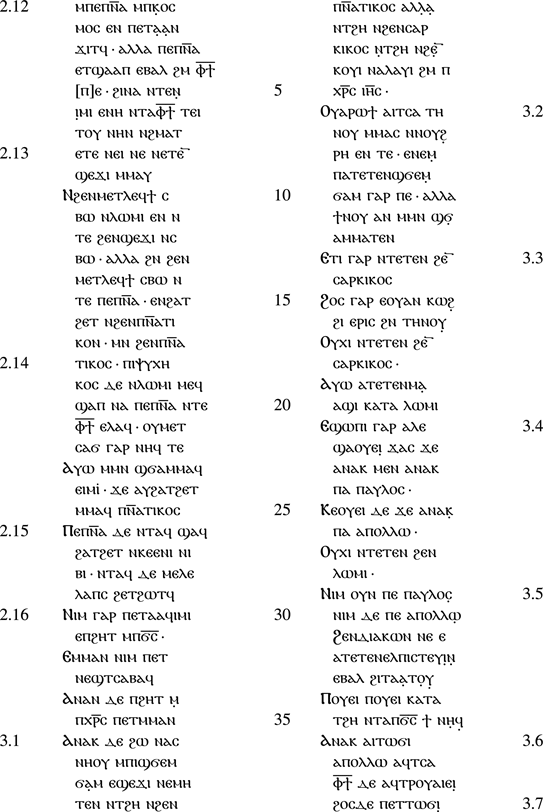
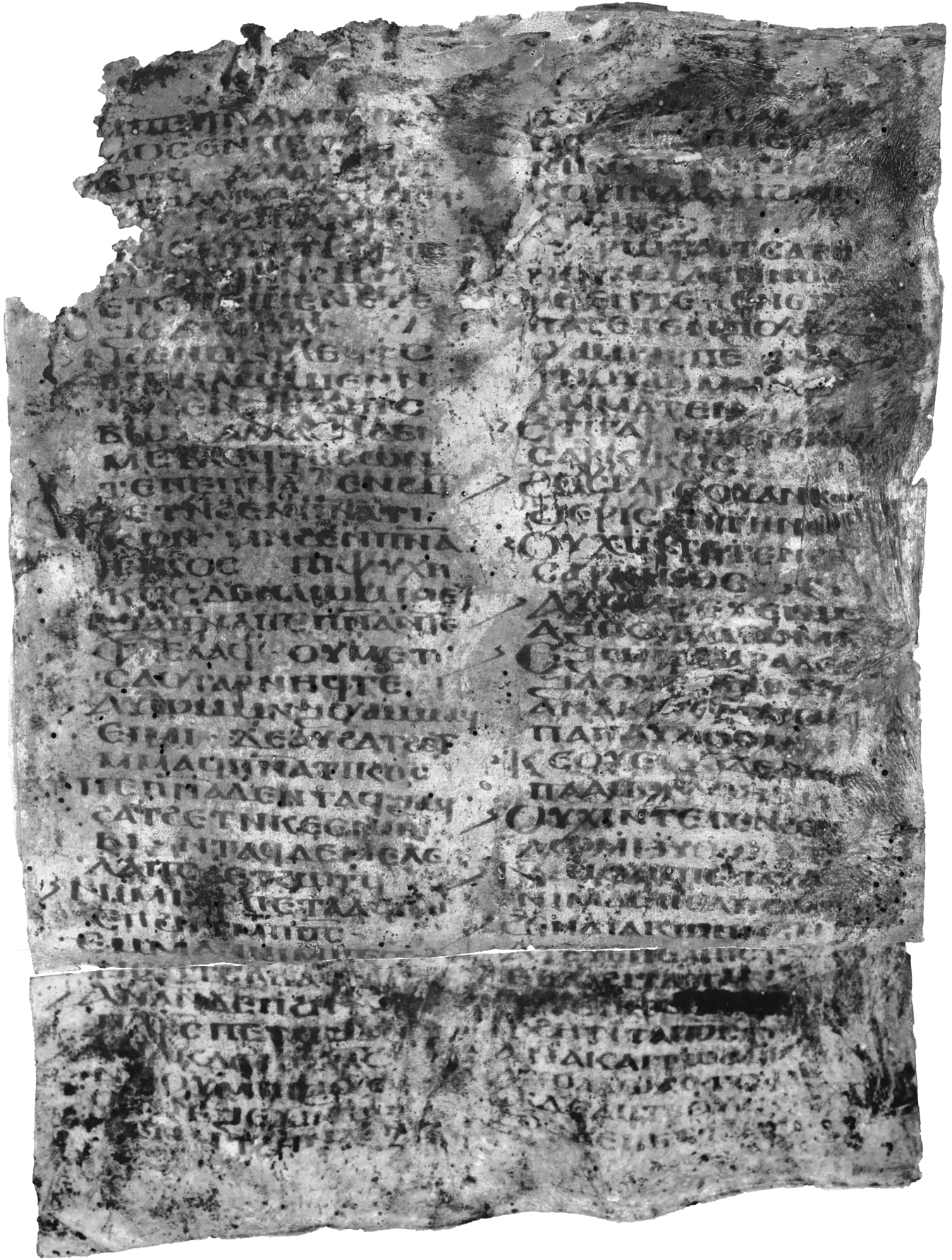
Figure 1. The Morgan Library & Museum, MS M.585, fol. 50v + fol. ir. Purchased for J. Pierpont Morgan (1837–1914) in 1911. Digitally reassembled by Ivan Miroshnikov.
Fol. (c + a)v (MS M.585, fol. 50r + fol. iv; see Fig. 2)
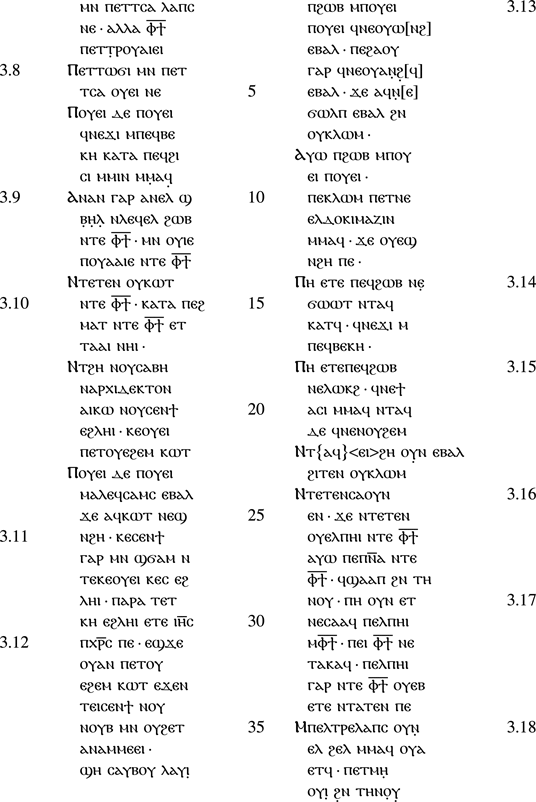
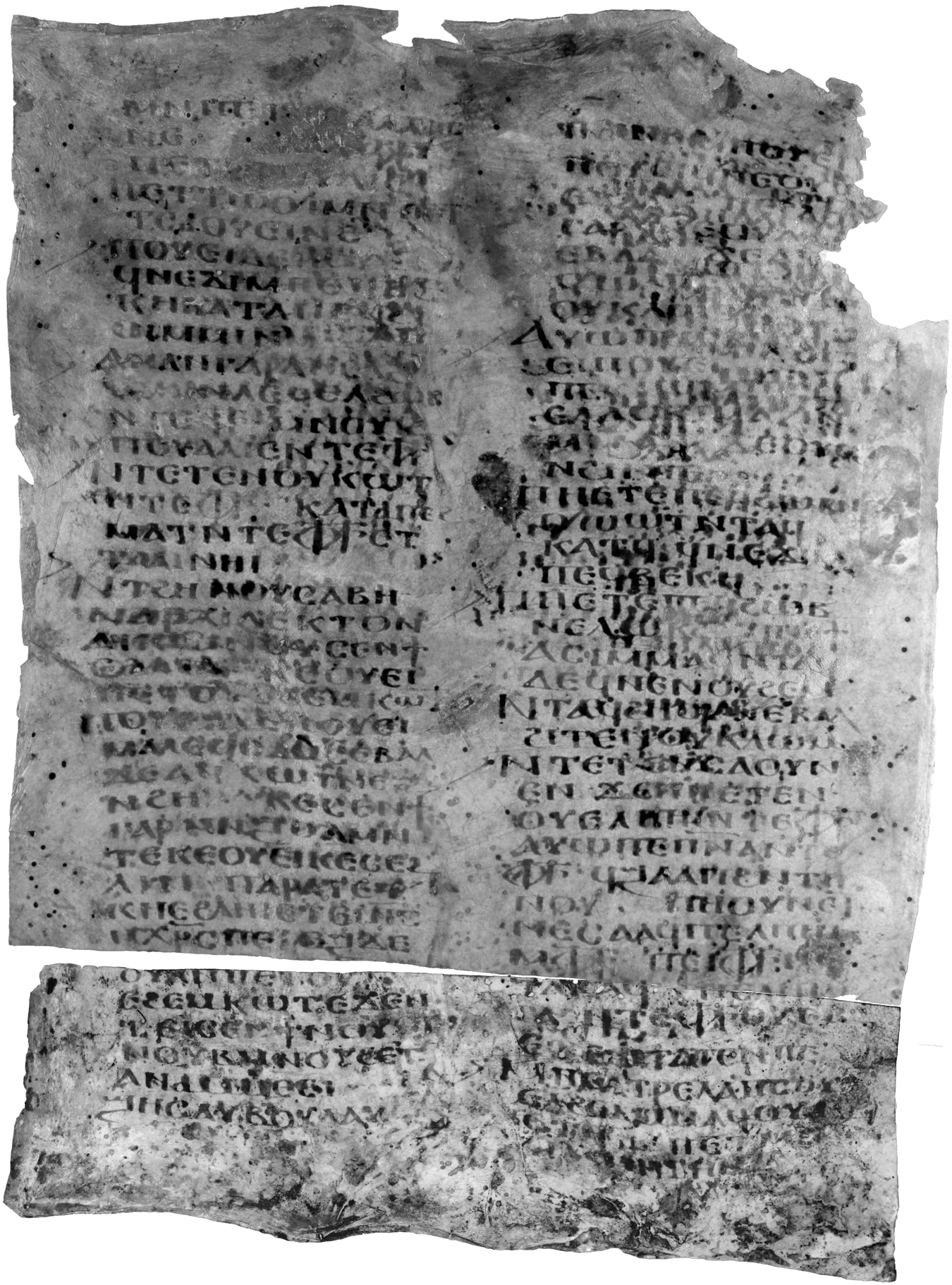
Figure 2. The Morgan Library & Museum, MS M.585, fol. 50r + fol. iv. Purchased for J. Pierpont Morgan (1837–1914) in 1911. Digitally reassembled by Ivan Miroshnikov.
Fol. (d + e)r (MS M.585, fol. 51v + fol. 51r; see Fig. 3)
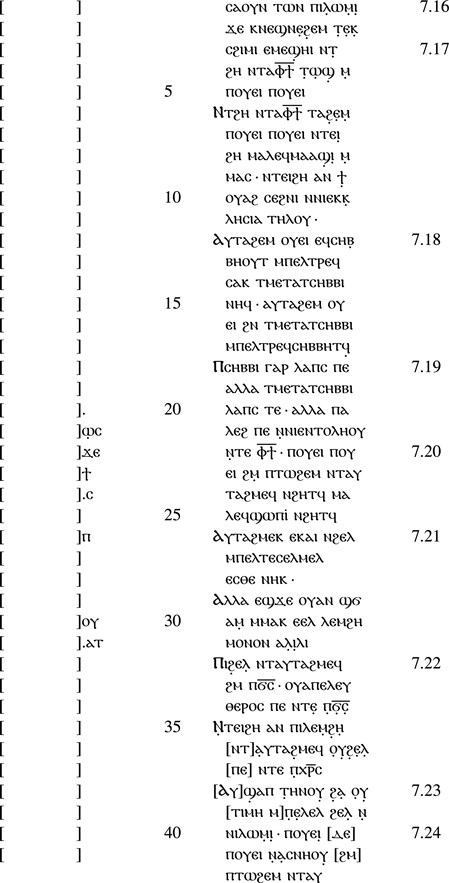
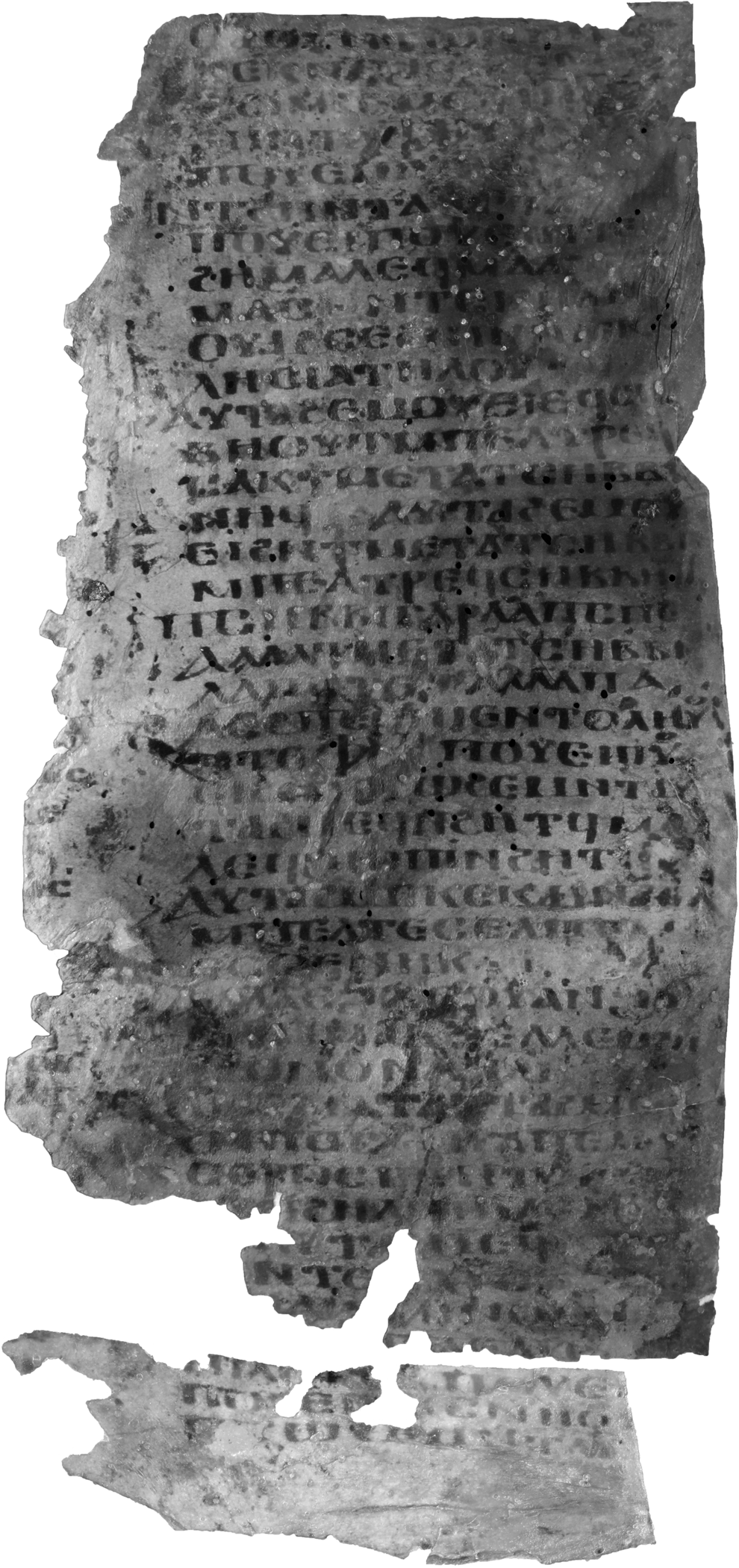
Figure 3. The Morgan Library & Museum, MS M.585, fol. 51v + fol. 51r. Purchased for J. Pierpont Morgan (1837–1914) in 1911. Digitally reassembled by Ivan Miroshnikov.
Fol. (d + e)v (MS M.585, fol. 51r + fol. 51v; see Fig. 4)
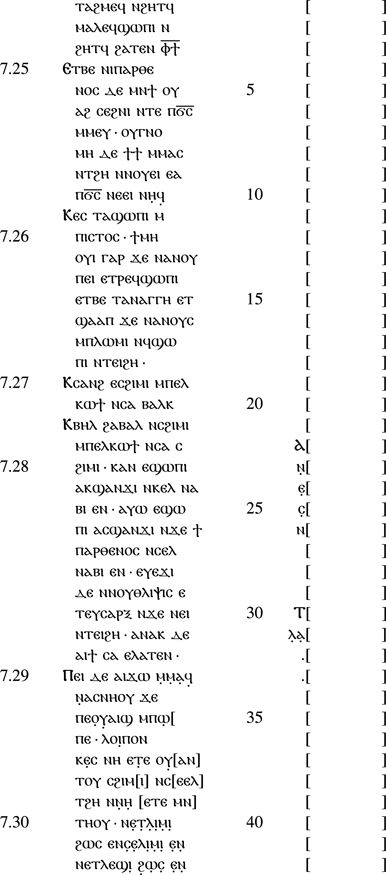
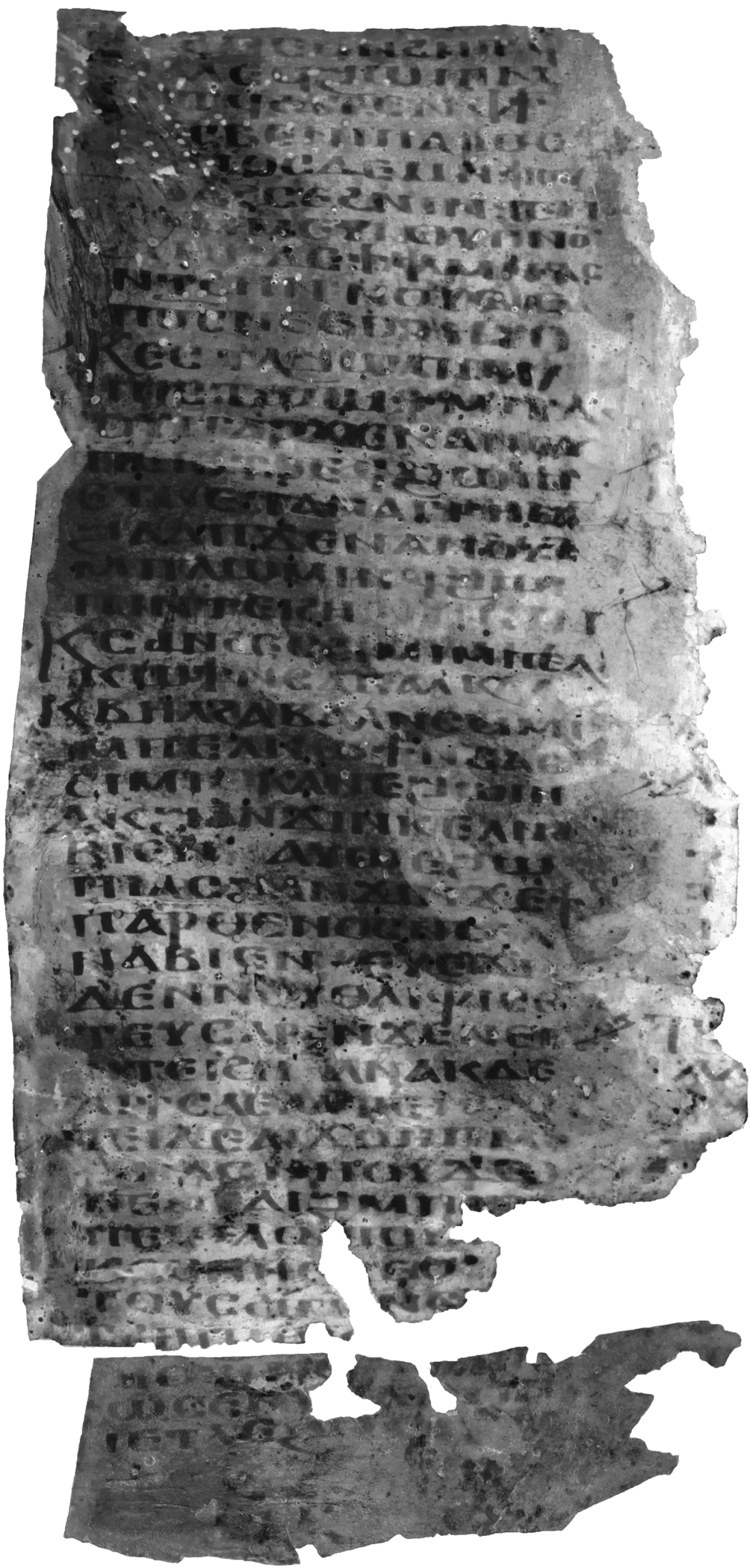
Figure 4. The Morgan Library & Museum, MS M.585, fol. 51r + fol. 51v. Purchased for J. Pierpont Morgan (1837–1914) in 1911. Digitally reassembled by Ivan Miroshnikov.
Fol. (b)r (MS M.585, fol. iir; see Fig. 5)
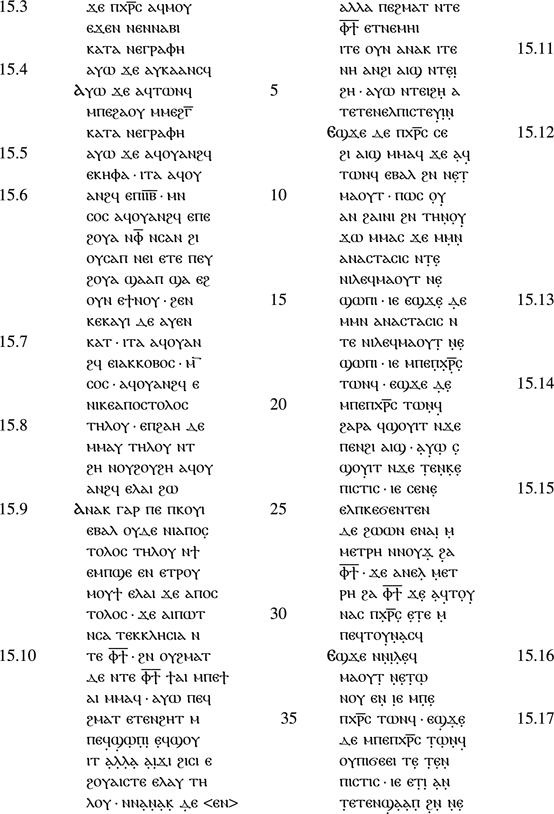
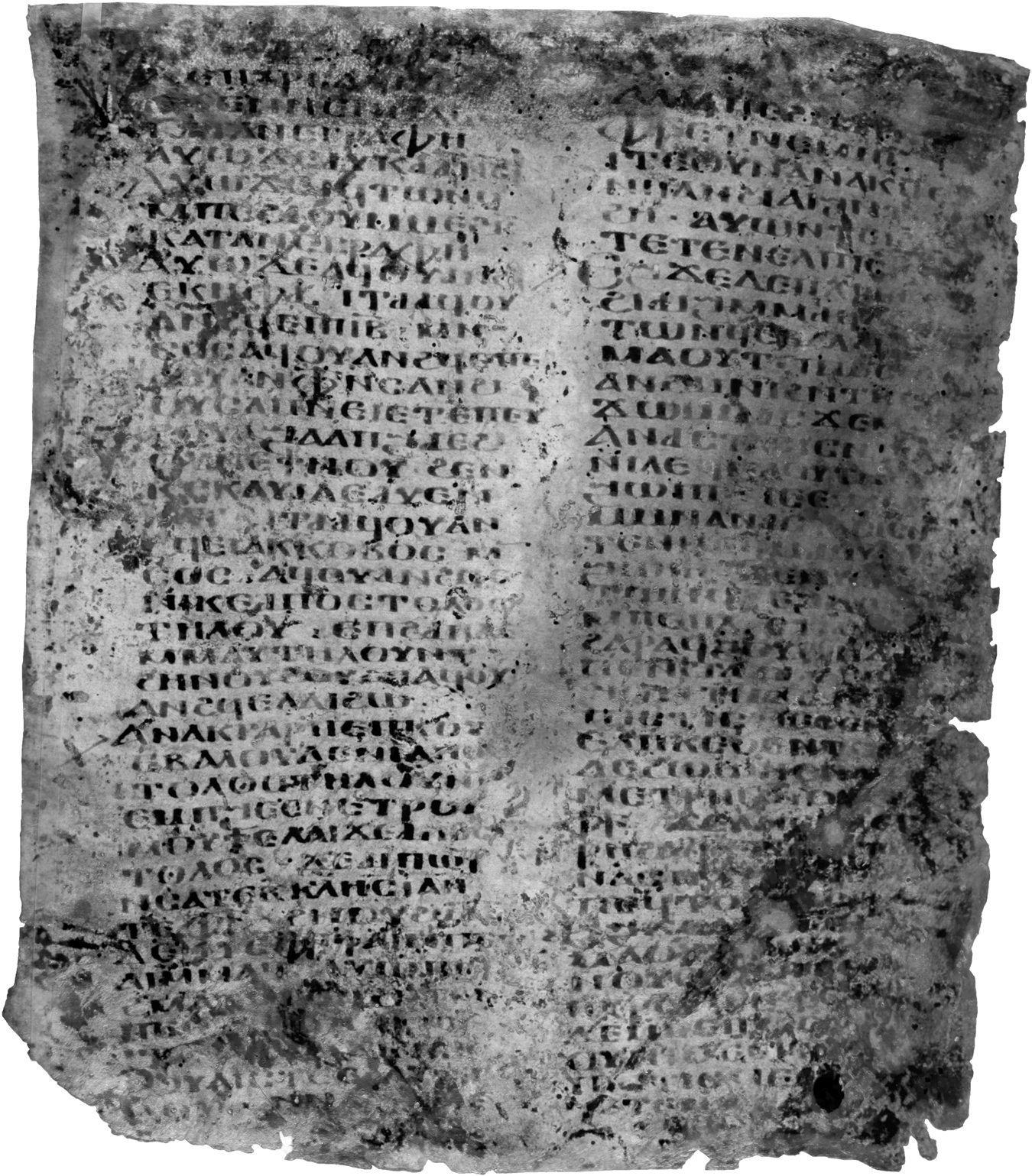
Figure 5. The Morgan Library & Museum, MS M.585, fol. iir. Purchased for J. Pierpont Morgan (1837–1914) in 1911.
Fol. (b)v (MS M.585, fol. iiv; see Fig. 6)
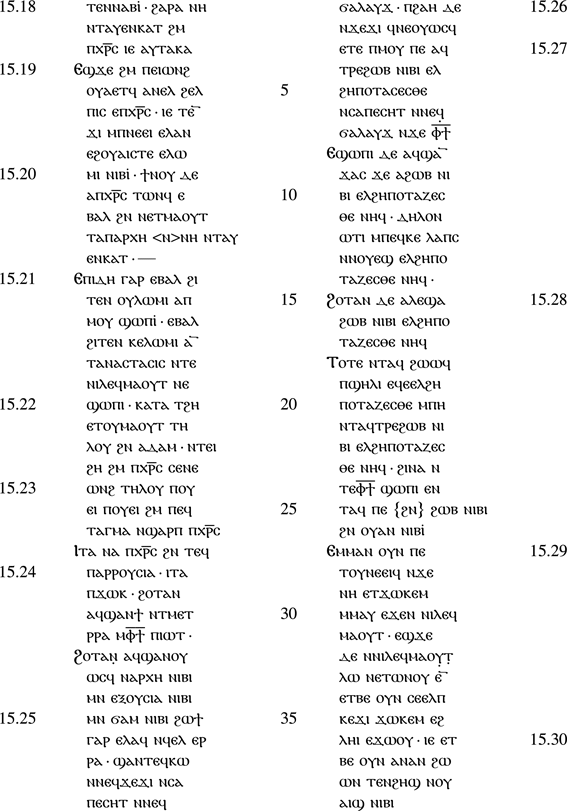
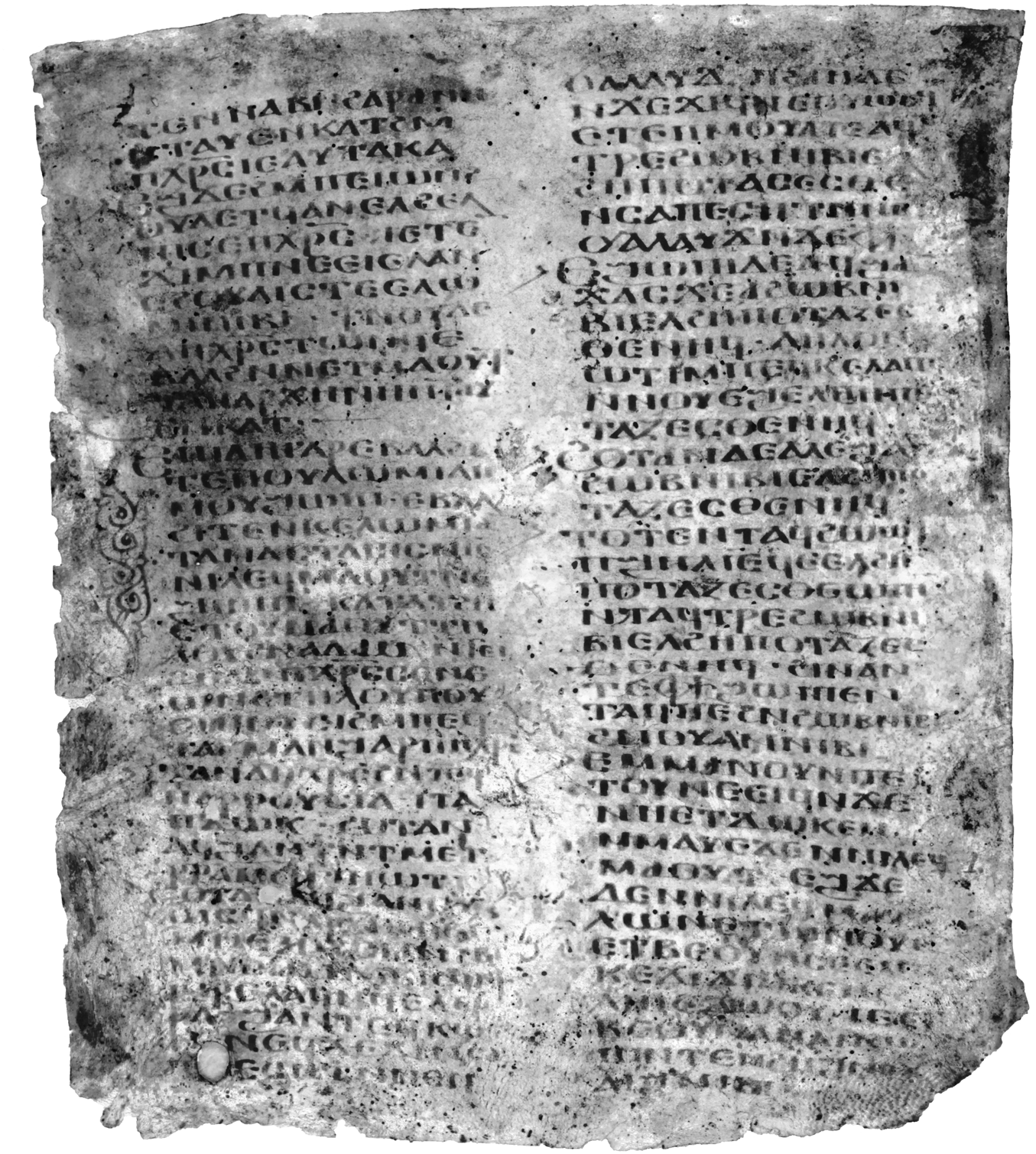
Figure 6. The Morgan Library & Museum, MS M.585, fol. iiv. Purchased for J. Pierpont Morgan (1837–1914) in 1911.
Notes on the Coptic Text
(3.15) ⲛⲧ{ⲁϥ}<ⲉⲓ>ϩⲏ: the scribe wrote ⲛⲧⲁϥϩⲏ instead of ⲛⲧⲉⲓϩⲏ, a scribal mistake triggered by the word ⲛⲧⲁϥ, which occurs earlier in the same verse.
(7.16) ⲥⲁⲟⲩⲛ: the last line of the preceding leaf most certainly read [ⲁⲕ].
(7.24) [ⲇⲉ]: the line appears to be too short in comparison to the ones above and below, unless we supposed that a few letters were lost in the lacuna. I restore [ⲇⲉ], assuming that fa agrees with the variant reading attested in several witnesses of bo.
(7.29) ⲙⲡⲱ̣[: I leave the word ‘withdrawal’ (B5 ⲱⲣϥ) unrestored, because it is unclear whether or not it was subject to lambdacism in F5.
(15.10) <ⲉⲛ>: although the text at the bottom of fol. (b)r is poorly legible, it seems certain that, at the end of the first column, there is no text after ⲇ̣ⲉ. In all likelihood, the scribe omitted ⲉⲛ by mistake in the transition from the last line of the first column to the first line of the second column. An enticing alternative to this emendation is to suggest that ⲛⲛ- before ⲁ̣ⲛ̣ⲁ̣ⲕ̣ functions as the sole negator in this sentence – a phenomenon that, according to Wolf-Peter Funk, seems to occur in several Coptic dialects, including M, B4 and B5.Footnote 40 However, since this phenomenon seems to be otherwise unattested in Fayyūmic and since the parallel text of P.MorganLib. 268 does not omit ⲉⲛ, I have chosen to emend the text.
(15.12) ⲙⲙ̣ⲛ̣ | ⲁⲛⲁⲥⲧⲁⲥⲓⲥ: only the traces of what seems to be a vertical stroke are discernible after ⲙ. This vertical stroke can belong to either ⲙ or ⲛ; thus, the manuscript may have read either ⲙⲙ̣ⲛ̣ or ⲙⲛ̣. Given that, in the next verse, just a few lines below, the manuscript reads ⲙⲙⲛ ⲁⲛⲁⲥⲧⲁⲥⲓⲥ, I have opted for the former option.
(15.14) ⲧ̣ⲉⲛ̣ⲕ̣ⲉ̣|ⲡⲓⲥⲧⲓⲥ: although all witnesses of bo read ⲡⲉⲧⲉⲛⲕⲉⲛⲁϩϯ, the vertical ink trace following ⲧ̣ⲉ is compatible with ⲛ, but not ⲧ, which means that the manuscript could not have read ⲧ̣ⲉⲧ̣ⲉ̣ⲛ̣-.
(15.17) ⲧ̣ⲉ̣ⲛ̣|ⲡⲓⲥⲧⲓⲥ: the ink traces at the end of line 37 are impossible to discern. However, though all witnesses of bo read ⲡⲉⲧⲉⲛⲛⲁϩϯ, the available space seems to make the reading ⲧ̣ⲉ̣ⲧ̣ⲉ̣ⲛ̣|ⲡⲓⲥⲧⲓⲥ rather unlikely.
(15.20) <ⲛ>ⲛⲏ: admittedly, the omission of the linkage marker ⲛ- may be due to ‘phonetic’ haplography; however, since this is the only instance of the omission of the initial morphemic ⲛ in this manuscript, I find it more plausible that the scribe made a mistake.
(15.28) {ϩⲛ}: the scribe wrote the preposition ϩⲛ before ϩⲱⲃ ⲛⲓⲃⲓ by mistake, in anticipation of the ϩⲛ that occurs before ⲟⲩⲁⲛ ⲛⲓⲃⲓ later in this verse.
Translation
(2.12) … what we received was not the spirit (πνɛῦμα) of the world (κόσμος), but (ἀλλά) it was the Spirit (πνɛῦμα) from God, that (ἵνα) we might understand the things that God gave us as a gift (2.13) – these things that we speak – discerning, along with spiritual people (πνɛυματικός), spiritual things (πνɛυματικόν), not through the human teachings of wise words but (ἀλλά) through the teachings of the Spirit (πνɛῦμα). (2.14) Indeed (δέ), the psychical (ψυχικός) person never receives the things belonging to the spirit (πνɛῦμα) of God, for (γάρ) it is foolishness for him. And he is unable to understand, for it is discerned spiritually (πνɛυματικῶς). (2.15) The Spirit (πνɛῦμα), on the other hand (δέ), discerns everything, but (δέ) it itself no one discerns. (2.16) For (γάρ) ‘who has known the mind of the Lord, or who will be able to instruct him?’Footnote 41 As for us, on the other hand (δέ), we have the mind of Christ.
(3.1) Hence (δέ), my brothers, I myself could not speak to you as I might speak to spiritual people (πνɛυματικός) but (ἀλλά) to fleshly ones (σαρκικός), to little children in Christ Jesus. (3.2) I gave you milk to drink – it is not food – for (γάρ) you were not yet capable.Footnote 42 But (ἀλλά) now, too, you are not capable. (3.3) For (γάρ) you are still (ἔτι) fleshly people (σαρκικός). For (γάρ), as long as (ὡς) there is envy and discord (ἔρις) among you, is it not so (οὐχί) that you are fleshly (σαρκικός) and walk as (κατά) humans? (3.4) For (γάρ) if someone says, ‘As for me, I, on the one hand (μέν), belong to Paul’, and someone else, on the other hand (δέ), ‘I belong to Apollos’, is it not so (οὐχί) that you are human? (3.5) Who, then (οὖν), is Paul, and (δέ) who is Apollos? They are servants (διάκων) through whom you came to believe (πιστɛύɛιν), each one in (κατά) the manner the Lord assigned him. (3.6) I planted, Apollo watered, but (δέ) God made them grow. (3.7) Therefore (ὥστɛ), neither the one who plants nor the one who waters is anything,Footnote 43 but (ἀλλά) God, the one who causes them to grow.Footnote 44 (3.8) The one who plants and the one who waters are one, and (δέ) each will receive his wage according to (κατά) his labour. (3.9) For (γάρ) we are God's fellow workers, and you, God's tillage, are God's building, (3.10) according to (κατά) the grace of God given to me. Like a wise master-builder (ἀρχιτέκτων), I laid the foundation; someone else continues to build. But (δέ) let each one pay heed to how he builds. (3.11) For (γάρ) it is impossible for someone else to lay a foundation other than (παρά) the one that is laid down – namely, Jesus Christ. (3.12) If there is someone who continues to build on this foundation with gold, silver, precious stones, wood, hay or straw, (3.13) the work of each one will be revealed. For (γάρ) the day will reveal [him],Footnote 45 because itFootnote 46 will be disclosed in fire, and the fire is what will assay (δοκιμάζɛιν) the work of each one – namely, of what sort it is. (3.14) He whose work – which he built – will remain, will receive his wage. (3.15) He whose work will burn, will lose it. Yet (δέ) he himself will be saved but (οὖν) in <this> way: through fire. (3.16) Do you not know that you are a temple of God and that the Spirit (πνɛῦμα) of God dwells in you? (3.17) He, then (οὖν), who will defile the temple of God will be destroyed by God. For (γάρ) the temple of God – namely, you – is holy. (3.18) And (οὖν) let no one deceive himself. He who thinks among you …
(7.16) … how [do you] know, husband, that you will be able to save your wife, (7.17) except the way God appointed each one? Just as God called each one, so let him walk. And so also do I command all the churches (ἐκκλησία). (7.18) Was someone circumcised called? Let him not draw out his uncircumcision.Footnote 47 Was someone uncircumcised called? Let him not circumcise himself. (7.19) For (γάρ) circumcision is nothing, but (ἀλλά) uncircumcision is (also) nothing. Rather (ἀλλά), it is the observance of God's commandments (ἐντολή).Footnote 48 (7.20) Let each one be in the calling to which he was called. (7.21) Were you called while being a slave? Let it not be a concern (μέλɛσθαι) for you. But (ἀλλά) if you can become free, do only (μόνον) this. (7.22) A slave who was called in the Lord is the Lord's freedman (ἀπɛλɛύθɛρος). So also a free individual who was called [is] a slave of Christ. (7.23) [You were] bought with a [price (τιμή)]; do not become slaves of humans. (7.24) [And (δέ)] let each one, my brothers, be with God [in] the calling to which he was called. (7.25) Now (δέ), concerning virgins (παρθένος), I have no commandment of the Lord,Footnote 49 but (δέ) I give an opinion (γνώμη) as someone on whom the Lord had pity, so that I became faithful (πιστός). (7.26) For (γάρ) I think that it is good for this to be soFootnote 50 because of the present distress (ἀνάγκη), that it is good for man to be this way. (7.27) Are you bound to a wife? Do not seek to untie yourself. Are you untied from a wife? Do not seek a wife. (7.28) Even if (κἄν) you should marry, you do not sin. And if a virgin (παρθένος) marries, she does not sin. But (δέ) people of such a sort shall receive affliction (θλῖψις) in their flesh (σάρξ), though (δέ) I am sparing you. (7.29) But (δέ) I tell you this, my brothers: it is the time of [withdrawal], so that henceforth (λοιπόν) those who have wives ought to [be] like those [who] do [not]; (7.30) those who weep as though (ὡς) not weeping, those who rejoice as though (ὡς) not …
(15.3) … that Christ died for our sins, according to (κατά) the scriptures (γραφή), (15.4) and that he was buried, and that he rose on the third day, according to (κατά) the scriptures (γραφή), (15.5) and that he appeared to Cephas, then (ɛἶτα) he appeared to the twelve. (15.6) Then he appeared to more than 500 brothers at once, of whom the most remain until now, while (δέ) others have fallen asleep.Footnote 51 (15.7) Then (ɛἶτα) he appeared to James, then he appeared to all the other apostles (ἀπόστολος). (15.8) And (δέ) last of all, like to an untimely birth, he appeared to me, too. (15.9) For (γάρ) I am the least of all the apostles (ἀπόστολος). I am not worthy to be called ‘apostle’ (ἀπόστολος), because I persecuted the church (ἐκκλησία) of God. (15.10) But (δέ), by God's grace, I am who I am. And his grace, which is in me, has not become empty, but (ἀλλά) I toiled more than all of them – though (δέ) not I, but (ἀλλά) the grace of God which is with me. (15.11) Whether (ɛἴτɛ), then (οὖν), I or (ɛἴτɛ) those ones, we are proclaiming in this way and in this way have you come to believe (πιστɛύɛιν). (15.12) But (δέ) if Christ is proclaimed, that he rose from the dead, how (πῶς) is it that some of you say that there will be no resurrection (ἀνάστασις) of the dead? (15.13) And (δέ), therefore, if there should be no resurrection (ἀνάστασις) of the dead, then Christ did not rise. (15.14) And (δέ) if Christ did not rise, then (ἄρα) our proclamation is empty, and our faith (πίστις) is also empty. (15.15) And (δέ), therefore, we ourselves will also be found false witnesses against God, because we bore witness to God, that he raised Christ, whom he did not raise. (15.16) If the dead should not rise, then Christ did not rise. (15.17) And (δέ) if Christ did not rise, our faith (πίστις) is vain; therefore, you are still (ἔτι) in your sins. (15.18) Then (ἄρα) those who have fallen asleep in Christ have perished. (15.19) If it is only in this life that we set our hopes (ἐλπίς) on Christ, then we are pitied more than any human being. (15.20) But (δέ), now, Christ rose from the dead, the first fruits (ἀπαρχή) <of> those who have fallen asleep. (15.21) For (γάρ) since (ἐπɛιδή) death happened through a man, the resurrection (ἀνάστασις) of the dead will also happen through a man. (15.22) Just as (κατά) they are all dead in Adam, so also will they all live in Christ, (15.23) each one in his order (τάγμα): first Christ, then (ɛἶτα), at his coming (παρουσία), those who belong to Christ. (15.24) Then (ɛἶτα) (comes) the end, after (ὅταν) he has delivered the kingdom to God the Father. After (ὅταν) he has destroyed every rule (ἀρχή), and every authority (ἐξουσία), and every power, (15.25) indeed (γάρ), he must reign until he has put his enemies under his feet. (15.26) And (δέ) the last enemy will be destroyed – namely, death. (15.27) ‘God made everything be subject (ὑποτάσσɛσθαι) under his feet.’Footnote 52 And (δέ) if heFootnote 53 says that everything became subject (ὑποτάσσɛσθαι) to him,Footnote 54 it is evident that (δῆλον ὅτι) heFootnote 55 did not leave anything without it being subject (ὑποτάσσɛσθαι) to him.Footnote 56 (15.28) And (δέ) after (ὅταν) everything has become subject (ὑποτάσσɛσθαι) to him, then (τότɛ) he himself, the Son, shall become subject (ὑποτάσσɛσθαι) to the one who made everything be subject (ὑποτάσσɛσθαι) to him, so that (ἵνα) God might be everything in everyone. (15.29) Otherwise, what will those who are baptised with water for the dead do? Indeed (δέ), if the dead should never rise, why do they receive baptism for themFootnote 57 also? (15.30) Then why are we ourselves always in distress? …
Competing interests
The author declares none.





